Knowing what modes of conveying are possible for a given material allows for the right equipment selection
November 29, 2021

Colin Barbeau, bulk materials handling specialist, Hatch
Bulk materials handling (BMH) system selection and design highly depends on the type of material handled. I have had the opportunity of working with various materials in my career, ranging from run-of-mine boulders to very fine powders and challenging one-of-a-kind materials, like crushed electronics, alternative fuels, and wait for it...cow heads! Understanding how a material behaves is fundamental in selecting the right equipment with the right features for reliable operations.
In this article, we focus on materials with relatively small particles handled pneumatically. One question that is often asked is, “Should we use a dilute phase system or a dense phase system?” We know phase selection (or mode of conveying) is significantly influenced by the general parameters of the application (available air source and pressure, length, capacity, etc.). It is also important to note how the material behaves when interacting with the pneumatic system’s transport gas (typically air). Powders and small size materials can have significantly different properties that either make them suitable or not for a given mode of conveying.
Let’s explore how we can better predict materials behavior and use this as a guide to help select the most appropriate mode of conveying.
Bear in mind that it is easy to oversimplify this topic, especially for what happens with materials at low velocity. Some materials behave differently than what is described below. When in doubt, consult experts and get the materials tested for accurate results.
The Geldart Chart
In 1973, D. Geldart published a paper where, based on his experimentations and results from other research, he suggested that powders could be classified into four categories based on their particle size and true density. When aerated, materials within the same category behaves similarly. Even though Geldart refers to these materials as powders, the particle size range covered in his results ranges from a few microns to a few millimeters.
From this data, Geldart created a chart (the Geldart chart), which presents boundaries between the four product categories with particle diameter and true particle density on the X and Y axis, respectively.
* Particle diameter: This is the equivalent spherical diameter of the particles and is an industry standard to easily describe and compare particle size of irregular shapes.
* True particle density: The density of the particles (sometimes also called specific gravity), not to be confused with the material’s bulk density, which is lower than actual density since it includes the voids between the particles when measured.
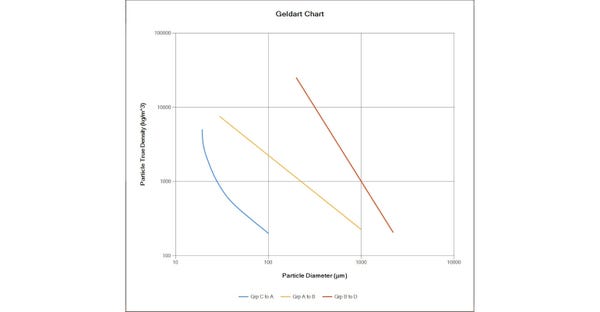
Figure 1: Geldart chart from PneuCalc pneumatic conveyor design software
Knowing the Geldart category of a material will avoid pitfalls early on by providing a clear indication of how the material should react in a pneumatic conveyor and its ability to be fluidized and retain that fluidization. Let’s explore this, but first, we need to agree on the definition of different modes of pneumatic conveying.
Modes of Conveying
Dilute Mode
In the dilute mode, the material-to-air ratio is very low, and air velocity is well above the particles’ saltation velocity and keeps all the particles in suspension throughout the whole cross-section of the pipe. Any material can be conveyed in a dilute phase if it can be fed into the pipeline. Depending on particle size and density, it might need an excessive amount of air and a high velocity, creating a high abrasion rate on the pipeline and particle breakage. This is why other modes of conveying at lower speeds are sometimes better suited for a specific application.
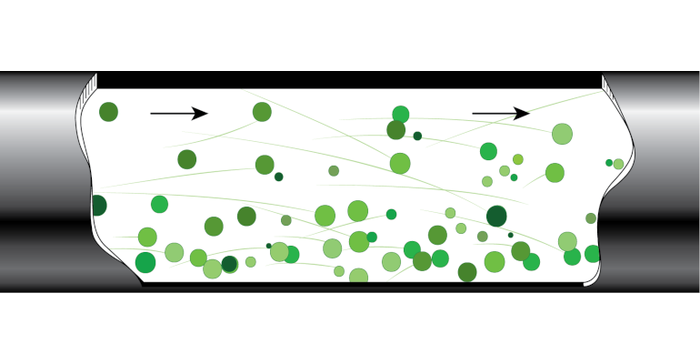
Figure 2: Dilute mode of conveying
Mixed Mode
Mixed mode takes place at lower velocities than dilute mode, near the material saltation velocity. Most particles are sliding at the bottom of the pipe in an aerated bed, with some particles carried in dilute mode above this sliding bed. For this mode of conveying to be possible, the material must be fluidizable. It must have good air retention properties to maintain a fluidized state throughout the pipeline, from the feed point to the discharge point of the conveyor. If the sliding bed loses its fluidized state, it might stall and initiate line plugging.
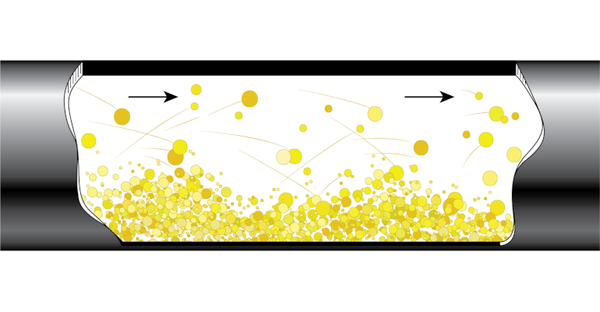
Figure 3: Mixed mode of conveying
Permeable Dense Phase Mode
In the permeable dense phase, aerated plugs of materials move throughout the pipeline. This mode of conveying occurs below the material saltation velocity and is possible with materials that are permeable to air, allowing air to penetrate through the plugs during transportation. If the material loses its aerated state during transport, a non-permeable plug--sometimes called a piston--could form and plug the line. To help with fluidization and control a plug's length, suppliers have designed clever ways to reduce plugs by injecting additional air into the pipeline at intervals. This allows for a broader range of materials conveying in a dense mode that would otherwise not typically be suitable. These air injection devices will be referred to as “air assist” in this article.
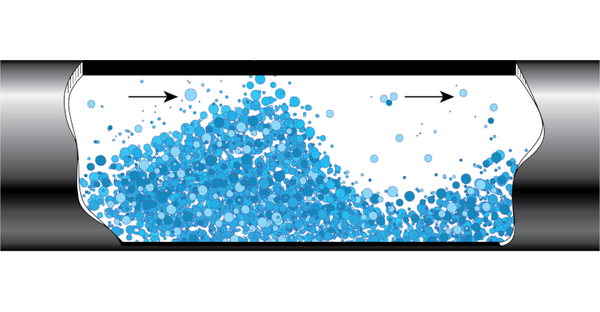
Figure 4: Permeable dense phase mode of conveying
Non-Permeable Dense Phase Mode
If a material that is non-permeable to air is fed into a pipeline at an airspeed below the material saltation velocity, it will form a plug that will not let air go through. It will act as a piston, as the air behind this plug of material will have to push it forward with brute-force pressure. Air does not interact with the particles in this mode of conveying, and it requires higher pressures to operate than the permeable dense phase mode. The conveying pressure is usually kept within design limits by a system that controls the length of these plugs and the number of plugs in the pneumatic conveyor at a time.
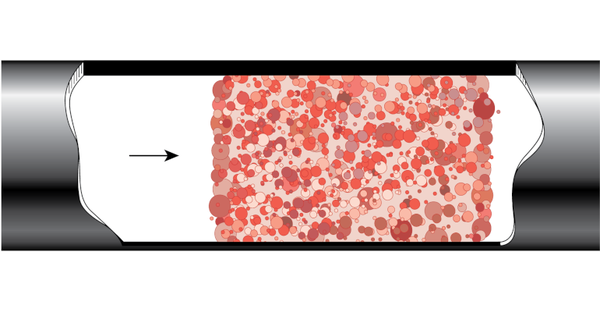
Figure 5: Non-permeable dense phase mode of conveying
Geldart Categories
Now that we have looked at the modes of conveying, let’s dive into what makes the material properties of each of the Geldart categories unique and what this means when selecting a mode of conveying. We will look at the chart from left to right, from the smallest particle diameter to the largest particle diameter.
Category C
These particles are very fine, making them cohesive and typically not free-flowing. They tend to form a ball when compressed by hand, and they are non-permeable to air. For the purpose of this article, it is fair to say that they do not fluidize under normal circumstances.
* Dilute mode: Yes
* Mixed mode: No, the sliding bed will not fluidize.
* Permeable dense phase mode: No, the plugs will not fluidize.
* Non-permeable dense phase mode: Yes
Category A
Larger particle size or higher true density than category C. These materials are permeable and allow air to go between their particles. These materials will fluidize well and keep their fluidized state for a long time.
* Dilute mode: Yes
* Mixed mode: Yes, ideal candidate, the sliding bed will stay fluidized for a long time.
* Permeable dense phase mode: Yes, ideal candidate, the plugs will stay fluidized for a long time.
* Non-permeable dense phase mode: N/A, these materials are permeable to air.
Category B
Larger particle diameter or higher true density than category A. These materials are permeable to air and allow air to go between their particles. The main difference with category A materials is that category B materials will fluidize well with higher fluidization velocity but will lose their fluidized state quickly.
* Dilute mode: Yes
* Mixed mode: Possible if they can keep their fluidized state for the duration of the conveying. They might need air assists.
* Permeable dense phase mode: Possible if they can keep their fluidized state for the duration of the conveying. They might need air assists.
* Non-permeable dense phase mode: N/A, these materials are permeable to air.
Category D
The largest particle diameter and density of the Geldart chart. These materials are very permeable to air (large voids between particles). Still, they are not fluidizable. The voids between the particles are too large to produce air retention, except if the material is not monosized and contains fines from other Geldart categories. In that case, this material could be fluidizable to some extent.
* Dilute mode: Yes
* Mixed mode: No, except in the case when there are sufficient fines with the material.
* Permeable dense phase mode: Yes
* Non-permeable dense phase mode: N/A, these materials are permeable to air.
Conclusion
It is important to note that when determining the best pneumatic system design and component selection for either dilute or dense phase modes, you must also consider line charger specifications, system pressures, air volumes, and required filtration surfaces.
Hopefully this article has helped you better understand how to theoretically predict under which mode of conveying a given material can be handled and has provided the tools required to execute this first assessment. Knowing what modes of conveying are possible for any given material allows for the right equipment selection and makes it easier to evaluate the best solution for the project. See past articles by Jack Hilbert for detailed differences between dilute and dense modes of conveying that complement information in this article.
Colin Barbeau is bulk materials handling specialist, Hatch. For more information, visit www.hatch.com.
You May Also Like


